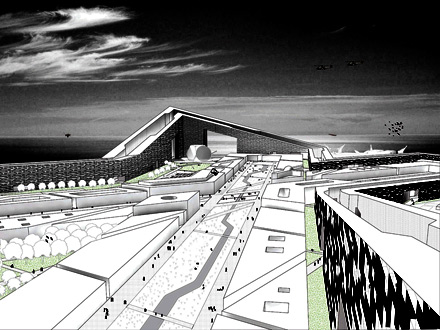Rice Students Design An Offshore Oilfield City of Tomorrow

A team of Rice University students have conceived an award-winning concept for a facility that would allow oil and gas employees to work and live offshore Brazil.
The three students on Team Petropolis – which included Alex Yuen, Joanna Luo, and Weijia Song – were presented with the opportunity to address the challenge Petrobras faces in housing workers as its exploration efforts move further offshore Brazil as part of the 2012 Challenge for the Odebrecht Award for Sustainable Development.
As part of the competition, the students addressed a need raised in a May 2011 Rio Times article. This article discussed the fact that Petrobras' fixed and floating platforms already serve as small autonomous floating cities with energy and water. But additional platforms will be needed to meet activity, and the growing distance of exploration offshore from the coast will make running helicopter trips unfeasible. To meet this need, Petrobras said it was planning 50 additional floating cities offshore Brazil.
To address Petrobras' offshore development and housing needs, the three architecture students – who were aided by advising professor Neeraj Bhatia – designed a 372-mile (600-kilometer) chain of manmade islands that can sustain 50,000 people, including spouses and children of the oil workers. As part of the project, "New Model of Water-Based Urbanization Offshore Southeast Brazil", the team created a master plan of a city that would utilize the Brazilian offshore current to sustain the island, saving energy.

The island chain would have three different hubs based on proposed offshore pipelines. The chain would run on a ballast water filtration distribution system and drilling waste treatment distribution system. It would not only incorporate components where drilling activity would take place, but also hub where crops could be grown. The chain would also have islands that would have housing, schools and churches. Drift boats and harvest boats would move along the island chain, transporting workers and food supplies.
In the proposed plan, the mobile oil boats move between the hub islands and the oil rigs. The boats would house off-duty workers, moving them away from the dangers and demands of the rigs, and transport oil and gas from rigs to the hub islands, where it would be piped back to the mainland for refinement. The hybrid boats would eliminate the costly need for a constant traffic of floating production storage and offloading vessels and floating storage offloading vessels from the rigs to the Brazilian coast.
The idea behind the students design was to create a sustainable community, said Luo, one of the students who helped design the island chain. Building a sustainable community would allow oil and gas companies to cut down on the number of boat trips between the rigs and shore, saving both money and fuel.
Crops grown on the agricultural islands would be based on the dietary needs of Brazilians, including wheat, fish, rice, starches, vegetables and fruit. The agricultural islands deployed along the lines of drift would be composed of three different island typologies, farming 12 different agricultural and aquacultural crops.
The floating island, the largest island, would be suited for cultivating grain, while the submerged island, supported by pontoon structures, would house aquaculture cultivators. The third type of island, the enclosed island, would offer climate control, much like a greenhouse, to grow fruits and vegetables.
Each agricultural island would sustain a different crop, rotating to a different crop cycle. Grains and fish would be the main staples of the residents' diet – the students didn't think it would be sustainable to bring cows onto the island – and an island that would allow fishing also would be included in the island chain. The agricultural hubs would provide food to feed workers, helping make the island chain financially sustainable.
"The island chain would allow workers to be able to sustain their families on these islands," said Joanna Luo, one of the students on the team. "It's about creating a more human, sustainable environment."
The three students last fall began researching the idea of using floating islands to access Brazil's pre-salt region. While the chain was designed according to the Brazilian current, it could be replicated elsewhere in the world if existing environmental conditions could be utilized, such as a drift pattern or the availability of solar or wind energy.
The competition was really about bringing new ideas to the table and giving the students exposure to the oil and gas and engineering communities.
"You can't push the envelope without taking risks," Luo noted.
The students are "amazed that the engineering community has so embraced our idea," Luo told Rigzone. "Coming from an architecture background that is pretty difficult," Luo added.
Team Petropolis' project fits in with a trend among a number of architecture firms who are rethinking how onshore cities are built, particularly in light of the flooding seen in the New York City area following Hurricane Sandy. The same trend can be seen with oil and gas facilities as oil becomes harder to find and oil and gas companies face increasingly challenging environments in accessing deepwater hydrocarbon resources.
For their efforts, the students in October were named the winners of the Odebrecht Award for Sustainable Development 2012 Challenge to come up with the next "Big idea" in sustainability. The three Rice juniors, their advising professor and the school split among themselves the $40,000 prize. The Rice team was among 422 students representing 40 nationalities and 173 universities who competed for the award.
The students were judged by a panel of experts in the range of fields, including construction, chemistry, engineering and sustainability. The teams' projects were measured on technical contribution, reasoning and depth, real-world applicability, and adherence to Odebrecht's multifaceted view of sustainability as a synergy of economic development, social development, environmental balance, political participation, and cultural diversity.
Odebrecht is a Brazilian multinational organization that operates in the engineering and construction, petrochemical, energy, bioenergy, oil and gas, real estate, and environmental engineering sectors.
WHAT DO YOU THINK?
Generated by readers, the comments included herein do not reflect the views and opinions of Rigzone. All comments are subject to editorial review. Off-topic, inappropriate or insulting comments will be removed.
- How Likely Is an All-Out War in the Middle East Involving the USA?
- Rooftop Solar Now 4th Largest Source of Electricity in Australia
- US Confirms Reimposition of Oil Sanctions against Venezuela
- Analyst Says USA Influence on Middle East Seems to be Fading
- EU, Industry Players Ink Charter to Meet Solar Energy Targets
- Russian Ships to Remain Banned from US Ports
- Brazil Court Reinstates Petrobras Chair to Divided Board
- EIB Lends $425.7 Million for Thuringia's Grid Upgrades
- Var Energi Confirms Oil Discovery in Ringhorne
- Seatrium, Shell Strengthen Floating Production Systems Collaboration
- An Already Bad Situation in the Red Sea Just Got Worse
- What's Next for Oil? Analysts Weigh In After Iran's Attack
- USA Regional Banks Dramatically Step Up Loans to Oil and Gas
- EIA Raises WTI Oil Price Forecasts
- How Likely Is an All-Out War in the Middle East Involving the USA?
- Venezuela Authorities Arrest Two Senior Energy Officials
- Namibia Expects FID on Potential Major Oil Discovery by Yearend
- Oil Markets Were Already Positioned for Iran Attack
- Is The Iran Nuclear Deal Revival Project Dead?
- Petrobras Chairman Suspended
- Oil and Gas Executives Predict WTI Oil Price
- An Already Bad Situation in the Red Sea Just Got Worse
- New China Climate Chief Says Fossil Fuels Must Keep a Role
- Oil and Gas Execs Reveal Where They See Henry Hub Price Heading
- Equinor Makes Discovery in North Sea
- Macquarie Strategists Warn of Large Oil Price Correction
- DOI Announces Proposal for Second GOM Offshore Wind Auction
- Standard Chartered Reiterates $94 Brent Call
- Chevron, Hess Confident Embattled Merger Will Close Mid-2024
- Analysts Flag 'Remarkable Feature' of 2024 Oil Price Rally


